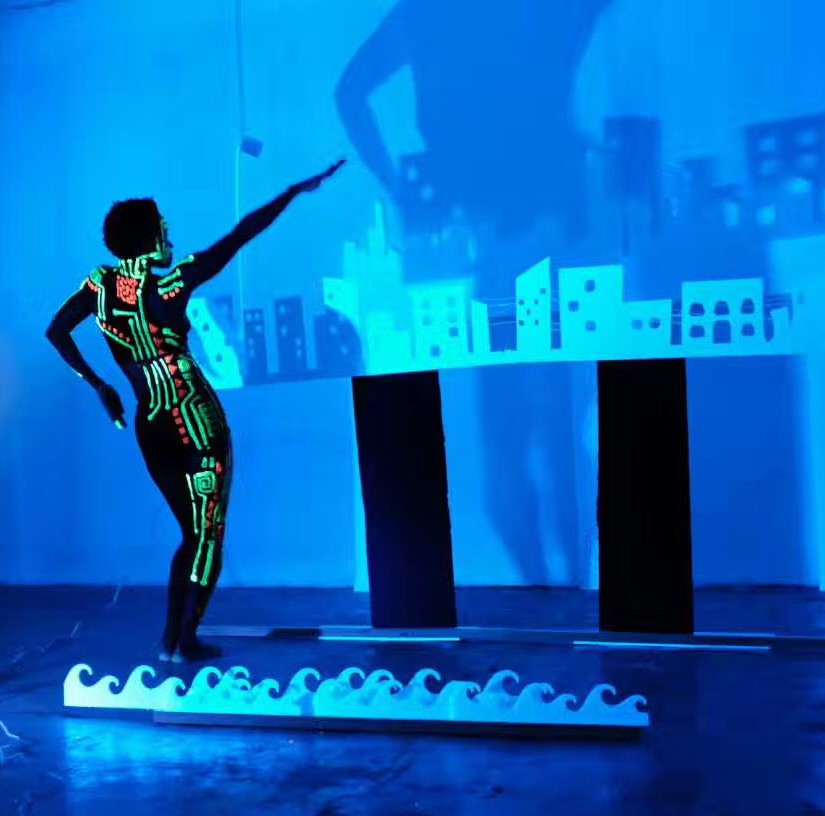This article was written by Mary Ann O’Donnell
2017年7月28日19:30(星期五)在现•象 城市工作室,凯瑟琳的展现沙龙更是一次开放式排练。参加沙龙的五十多位观众朋友成为凯瑟琳创作过程的见证人。 她和她的朋友遇见在白石洲,为城市和其城中村之间的生活做出低成本的高辛烷值表现。
On Friday, July 28 at 7:30 in the Phenomenon Studio, Catherine Nakawesa’s open house was in fact an open rehearsal. The fifty-odd guests who joined the salon were in fact witnesses to Catherine’s creative process. She and her friends came together in Baishizhou to produce a low cost high octane performance about life in and between the city and its urban villages.
表演开始之前,娜丁又名Akuine E.用发光油漆在凯瑟琳身体上画图案。 红色绿色的图案同时是抽象和具体的符号——亲,我们要不断的停下来再启动。 一方面,线条和三角形唤起了原始的渊源,毕竟人类本色和超出理性的城市环境是不一样的。 另一方面,身体上的图案在显示出我市的IT历史,從中我们也发現了山寨根源和机器人的梦想——血液、汗水、电线等配件组成深圳之軀。
Before the performance began, Nadine, aka Akuine E. painted Catherine’s body with glow in the dark paint. The red and green symbols were simultaneously abstract and concrete—stop and go, baby. On the one hand, the lines and triangles evoked a primal origin, something universally human and beyond rational categorization. On the other hand, within and against Shenzhen’s IT history, its shanzhai roots and robotic dreams, the body painting made salient the extent to which residents of the city are in fact cyborgs, fused of blood and sweat and wires.

本次表演的舞美由南荔工坊和x.factory的创客胡沁婷制造的。 她使用松木棍、kt板和绳子等元素代表深圳的海洋市景。胡沁婷还提供了一部紫外光和临时聚光灯,创造了不断变化的光影场面。
The stage was set by Rachel Hu, a hacker based at Litchee Lab and x.factory. Using pinewood sticks, kt board and string, she represented the landscape of Shenzhen—a city by the sea and in between its urban villages. Rachel also provided an ultra violet light and makeshift spotlight that created a constantly changing landscape of light and shadows.
音乐结合了新和旧、东和西以及南與南之間不同文化的来源之類,這些都深刻体现在城中村的多样性中。 表演开始,潮汕来的戴叔弹古琴。 戴叔在深圳已经生活了20多年,先后在岗厦、白石州等城中村居住,如今戴叔退休到赤湾,但他和孙女依然参加社区的文化活动。
The music for the performance combined old and new, east and west, a clear manifestation of the diversity of backgrounds that have been re-mixed in Shenzhen’s urban villages. The performance began with Uncle Dai playing the zither. A native of the Chaozhou-Shantou region, Uncle Dai has lived and worked in Shenzhen for over twenty years, making a living first in Gangxia and then in Baishizhou. Today, Uncle Dai has retired, but he and his grandchildren continue to participate in cultural events.
最終表演以白石洲居民马可的一個混搭曲“迷路”结束。 “迷路”表达了我们在深圳这样难以想象的城市中感受到的困惑。这种感受又具体又抽象——找不到北就容易感到失落,很難不怀疑自己的方向感。胡沁婷的kt板城中村用线条表现戴叔和马可同样的感受,即:线索明显摆在那里,看得见摸得到的实体,但是我们依然不清楚线条在哪里开始在哪里结束,更不清楚它们(最终)去哪里。 因为城市生活的密度本身超过了我们的想象能力,所以我们只好用一部分经验代表一个超现实的生活环境。
The performance concluded with “Lost,” a mash-up by Marco Flagg, a current resident of Baishizhou. “Lost” expressed the disorientation that overcomes us when we try to navigate a city as unwieldy as Shenzhen. Indeed, the threads that Rachel wove through the windows of her kt board urban village found musical expression in the juxtaposition of Uncle Dai’s live performance and Marco’s digital experiment. The connections are there, physical and inexorable, but it is unclear where they begin, where they end, and where they (ultimately) go. We are lost because the density of urban life itself surpasses our ability to do more than partially represent our experience.
一段诗歌弥合了戴叔和马可不同的音乐表现。 当她叙述如何来到白石洲又如何搬到梧桐山的经历时,凯瑟琳导航了脑海的困境,未来的我们不一定能留在现在我们的位置上,欲望让我们生活在一种永恒的离开中,什么感情什么东西什么样的国际化城市让我们都成为移民,让我们“失去”回家的可能性? 就这样,一座城市必然产生其城中村。
A section of poetry bridged the different musical expression of Uncle Dai and Marco. As she recited her experience of coming to Baishizhou and leaving it for Wutongshan, Catherine navigated the emotional space between who we want to be and what we flee, which is (when all is said and done) what makes immigrants of us all as capitalism not only expands, but also relentlessly creates and recreates the distance between high-rise having and urban village wanting.
他们唱到“第一次的伤害总是最深的。”
但如果每天都有一道新的伤口呢?
每个清晨,深圳都让我看到他的新脸孔。
我在她的迷宫里走失又找回。
They sang, “the first cut is the deepest.”
But what if there’s a new one every day?
Every morning, Shenzhen shows me a new side of his face.
I am lost and found in her maze.

凯思琳的行为表演让我联想到近70年前在纽约市格林威治村所发生的一些很影響的艺术实践,1959年10月Allan Kaprow在“村东”的鲁宾画廊举行《18件事情的六个部分》。这些事件让艺术家、表演者和观众等参与者反省空间的意义。一面空间是一个具体的地方,另一面它也是城市社会的比喻。此外,这种创造力的可能性来自于艺术表现的地方——城中村,导致了当代“廉价、未完成”的审美感。
Although nearly seventy years separates Catherine’s work from the heady experimentation of NYC during the late 1950s and early 1960s, nevertheless Friday night’s event resonates with accounts of Allan Kaprow’s “18 Happenings in 6 Parts,” which was held at the Reuben Gallery in New York’s East Village in October 1959. The happenings allowed the artist, the performers, and the audience to investigate space as both concrete place and as a metaphor for urban society. What’s more, the possibility of this kind of creativity comes from the place of artistic expression, resulting in an unfinished aesthetic.
最近艺术家罗伯特·惠特曼回顾说:“关于那次艺术实践,一切都是粗糙的、原始的,因为没有人真有钱可以花在材料上。 作品的舞美往往只有一个结构,没有人物也没有情节。比传统戏剧更加视觉化:艺术家强调的是构思的可操作性,而不是讲故事的。”
“Everything about the production was as crude and as primitive as it could be, because nobody really had any money to spend on any of this stuff,” the artist Robert Whitman told the New York Times in retrospect. And while Happenings often had a structure, there was no character development or plot: “It was generally more visual than traditional theater: the accent was on the plastic composition more than storytelling.”
这么说,最有时代感的艺术表现只能在纽约和深圳最有代表性的城中村。只要我们创意的目标是探索时代的特点,我们必须去其最明显的展现地——被不平等事實和超越现实的欲望擠兌出來的社区,也就是城中村。
It makes sense that artistic expression finds a home in New York’s East Village and Shenzhen’s Baishizhou. When the point is exploring what it means to be human, we need to be where our humanity is most clearly articulated—in enclaves that have been created by inequality and the longing to overcome it.
照片由深圳业余摄影爱好者和马龙·韦亚韦得提供,凯瑟琳诗歌翻译者王梅宝。
Photos of event curtesy of the Shenzhen Amateur Photo & MC Group and Marlon Villaverde, translation of Catherine’s poem by Nancy Wang.


